
How to attract the women-only tour market
Women are estimated to account for two thirds of the global traveller population (64%). This group includes women who travel in groups with other women and solo female travellers. This market is growing substantially, supported by a large market of specialist tour operators. It differs from the male travel market; addressing safety concerns is a major factor. However, the desire for authentic, immersive experiences and opportunities to connect with other women and communities offer great opportunities for tour operators that can meet their needs.
Contents of this page
1. What is the women-only tour market?
The women-only tour market refers to tourism trips exclusively for women and generally led by female guides. In many cases, the tour operator itself will also be owned and/or managed by women. The market includes accommodation establishments that cater only to women. Women-only travel groups can be made up of friends, other female relatives, partners and women who travel solo.
The women-only tour market shares many characteristics with the solo female travel market, which is a very significant niche. There is a large and growing body of women who travel solo. When women travel solo, this does not necessarily mean they travel completely alone. While many do, other solo travellers join small groups that are usually women only.
Women travel solo for many different reasons, from marital status to personal preference, which we explore later in the study.
2. Understand the female traveller market
Female travel has become significantly more important to the travel industry in recent years. It is estimated that 64% of travellers worldwide are female. There is a lot of speculation about why women travel more than men, especially as men tend to earn more than women, so affordability is not a factor. Reasons include being more adventurous and a desire to be more spontaneous. Women like to meet new people, often other women, and they enjoy making their own decisions. They also value learning more about themselves while they travel. These reasons differ from why men travel.
More women also choose to travel solo. Female travel and solo female travel are well represented in the market place; they have grown by 230% over the past few years. These days, many operators specialise in women-only travel and solo female travel. Most big name tour operators have specific services for these groups.
The value of the female travel market to the tourism industry is significant. Women are estimated to command spending power amounting to $15 trillion (USD), and 67 million women made travel decisions in 2024. It is estimated that female travellers spent $125 billion on travel experiences over the year. Women are also reported to spend more per day when they travel than men. These statistics suggest that women are becoming an even more important driver in tourism growth. Solo female travel is growing in popularity and thus importance. A 2024 survey found that solo female travellers accounted for 14% of female tourism demand.
Figure 1: Female solo travel is a growing travel niche
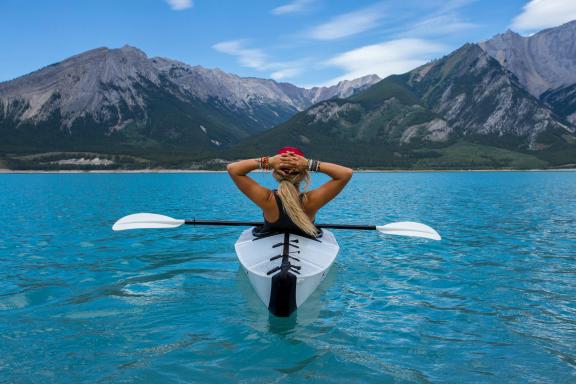
Source: Kalen Emsley at Unsplash, 2016
Characteristics of women travellers
We have seen that women account for more than two thirds of travellers. While this presents a great opportunity for tour operators, it is important to understand women travellers, who they are, what drives them and what their preferences are. Study these statistics about women-only and solo female travel to build a broad picture of their characteristics and travel motivations.
Table 1: Characteristics of women travellers
| Characteristics | % Share |
Demographics: Women travellers aged 25–30 Largest increase in solo female travel is in the 65+ age group Solo travellers aged 45+ Solo travellers aged 35–44 Solo travellers aged 25–34 Solo travellers aged 18–24 | 46% 18% 81% 13% 6% 1% |
Travel habits: Women make travel decisions. Women are not afraid to travel, no matter what is happening in the world Women predominantly take cultural, adventure and nature trips Women that have travelled in small group trips in the last 12 months Women interested in travelling in a group, either women-only or mixed gender Those who travel with other women, travel with female friends Those who travel with other women, travel with female relatives Affluent female travellers with incomes over $250,000 (USD) | 80% 86% 75% 21% 50% 91% 8% 54% |
Why women travel solo: Freedom and flexibility Get away from routine and responsibilities Relax, self-care and enjoy me-time Challenge themselves Do not have anyone to go with Easier to make new friends when travelling alone Enjoy autonomy Like to choose their destination Appreciate not needing to coordinate with someone else’s schedule | 87% 81% 78% 78% 51% 26% 22% 15% 6% |
Inspiration to travel: Beautiful scenery History, culture and education Beach escapes Adventure Cruises | 87% 17% 16% 15% 13% |
Factors in choosing a destination: Cultural/historical attractions Beauty of a destination Local cuisine Safety/crime rate Access to nature Good weather/climate Friendliness of the locals Value for money Country’s reputation Availability of adventure activities Accessibility of the destination | 77% 70% 65% 62% 61% 58% 56% 55% 52% 42% 39% |
Top activities of female solo travellers: Cultural sightseeing Nature and wildlife Cultural immersion Adventure activities Going to the beach Culinary activities Health and wellness Creative workshops/activities to learn a skill Volunteering Nightlife | 74% 71% 64% 55% 53% 49% 36% 32% 22% 21% |
Industry statistics: Travel agents reporting more female solo trips than male solo trips Female solo bookings have grown in the last few years A Google search of ‘solo female travel’ brings up 220 million results (2024), up from 45 million (2022) | 73% 45% |
Source: Condor Ferries; Solo Female Travellers Club; Forbes, 2024
It is interesting to note the differences between male and female solo travellers, as this will help you create strategies to attract the female market. The table below shows how women and men differ in terms of motivations, preferences and concerns. Safety and security concerns are key for this niche and are explored more in the following section.
Table 2: Differences between women and men solo travellers
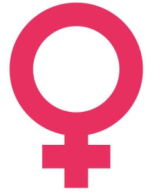
Solo female travellers | 
Solo male travellers |
Motivated by: Self-empowerment Self-discovery Personal challenges | Motivated by: Adventure Exploration Independence |
Preferences: Wellness and self-care experiences Connections with like-minded people | Preferences: Physical activities and adventure sports Off the beaten-track destinations |
Concerns: Safety and security | Concerns: Cost of travelling alone rather than in a group |
Source: Acorn Tourism Consulting, 2024
To find out more about the broader solo travel market, read the CBI study What are the opportunities in the European solo tourism market and watch the webinar Solo tourism as a European growth market.
Female travellers have specific concerns when they travel
Although women in Europe enjoy high levels of equality and are not generally discriminated against, they often have concerns that can influence their travel experiences. This is particularly true when they travel to places perceived as unsafe or where women do not enjoy the same freedoms. Women do considerable research to assess the safety of a destination before they travel. Read the article Female travel safety still needs improvement as an example of a resource used to make decisions.
The table below shows some of the major worries that women have when they travel.
Table 3: Concerns of women travellers
| What women regularly worry about | Where women feel the least safe |
Sexual harassment, assault, kidnapping – 50% Pandemic/public health emergency – 44% Cybercrime – 33% Terrorism, mass shootings – 30% Civil unrest – 29% Credit card scam – 28% Theft – 27% Personal medical emergency – 18% Natural disasters – 13% | Walking in the streets – 60% Driving in an unfamiliar location – 56% Using public transport – 47% Using a taxi or ride hailing experience – 47% At an airport or train station – 24% While on a plane or train – 16% In hotel public spaces – 15% In a hotel room – 10% At a restaurant – 6% |
Source: BCD, 2023
The key issues that women face when they travel are as follows:
- Safety. The risk of harassment, assault and theft are of significant concern to female travellers. They may worry about walking alone at night, using public transport or being in unfamiliar areas. There is a general concern that solo travellers may be targeted more frequently for scams, overcharging and dishonest behaviour. This is likely to be a bigger concern for women seen as more vulnerable.
- Harassment and unwanted attention. Catcalling, inappropriate comments and unwanted advances can be more prevalent in certain places. Women may also be concerned about sexual harassment. Solo female travellers are likely to take extra precautions when going out and socialising or trusting strangers.
- Cultural differences. There are cultural expectations of and restrictions on women’s behaviour, dress and mobility in many countries. This can make female travellers feel vulnerable. In some cultures, women who travel alone can face judgement or unwanted attention for not adhering to local norms. In some places, female travellers may be ‘easy targets’ for flirtation or harassment.
- Accommodation. Female travellers often prefer accommodation that is well-lit and safe. They also often choose women-only dormitories or floors in hostels and hotels. They look for locks and security systems. They may also want to know that their accommodation is close to safe areas, public transportation and central parts of the city to minimise the risk of unsafe situations.
- Health and wellbeing. Women may be more concerned about access to healthcare, especially if they travel in remote areas or countries with less developed health systems. This concern can be heightened if specific issues (e.g. pregnancy) arise or in areas where diseases are present.
- Hygiene: Finding clean and safe bathroom facilities is a concern of female travellers, especially in places where sanitation is limited.
- Overcharging or Scams. Some women worry about being taken advantage of financially when negotiating prices or paying for services. There is a perception that women, especially those who travel solo, are more susceptible to being overcharged.
- Language Barriers. Being in a country where one does not speak the language can heighten feelings of vulnerability, particularly in emergency situations or when navigating unfamiliar areas.
- Transportation. Concerns about the safety of public transportation, taxis and ridesharing services are causes for anxiety. Women on their own may feel uncomfortable using taxis or buses late at night or in isolated areas. Women who rent vehicles may be concerned about getting lost, breaking down in an unfamiliar area or facing harassment on the road.
The infographic below shows how men and women have different concerns when travelling alone and that women worry more overall. In particular, 46% of women are concerned about their personal safety compared to just 20% of men.
Figure 2: Concerns about going on solo holidays by gender, UK

Source: Statista, Tourlane, February 2020
Women are mindful when it comes to travelling. They are also careful when it comes to making decisions and judgements about their own personal safety. Generally, they are aware of their surroundings and take precautions. For instance, they may change accommodation if they perceive a threat. To attract this market, it is important to realise these are very real considerations that affect women travellers, especially those who travel alone.
You should assess every concern in relation to safe travel and ask yourself how you can mitigate against them. Be sure to address them clearly on your website so female travellers are reassured when doing their research.
Ways that women address their concerns about travelling solo or in women-only groups include the following.
- Researching destinations extensively before visiting so they are fully aware of the cultures of the places they chose. Female travellers educate themselves about local customs about modesty, how local women interact with men and what is considered appropriate for women who travel alone.
- Booking accommodation that is either female-friendly and/or has high safety ratings.
- Staying connected with friends and family at home while travelling.
- Carrying personal safety tools, such as pepper spray and alarms.
Women travelling for business
Women who travel for business have similar safety concerns. A 2018 survey found that 83% of women who travel for business had experienced at least one safety-related incident in the previous year. Another survey found that 71% of women business travellers say that business is less safe for women than it is for men. Surprisingly, specialist business tour operators do not often specifically address female business travellers’ safety and security.
However, there is evidence that improvements in airport and hotel design are being put in place to support female business travellers. For instance, more spaces for nursing mothers and women-only floors in hotels are being introduced. The Luthan Hotel and Spa in Riyadh is a women-only hotel, owned, managed and run solely by women. In Singapore, the JW Marriott Hotel Singapore South Beach is aimed at business travellers, and one floor is reserved for female guests. Women get access using special passes, and the floor is only serviced by women. Additional amenities are also provided, such as manicure and pedicure sets, and facial steamers.
To attract women business travellers to your accommodation, there some simple steps you can take to make them feel safe and welcome.
- Provide an escort to room service, preferably female, especially late at night.
- Assign rooms to female customers who are staying close to the lifts and away from isolated areas.
- Ensure your keys are unnumbered.
- Make sure the reception and corridor areas are well lit. Also install CCTV if you can.
3. Which European women like to travel and where to?
European women are some of the most likely in the world to travel solo. The top European markets are Germany, the UK, France, Spain and Italy. In 2024, more than 30% of German and British travellers who booked flights during the summer were solo female travellers. Of the top European markets, Spain and Italy are the most adventurous with almost half (48%) of Spanish and one third (36%) of Italian solo female travellers choosing international destinations over domestic ones.
Figure 3: Spanish and Italian female solo tourists are the most adventurous
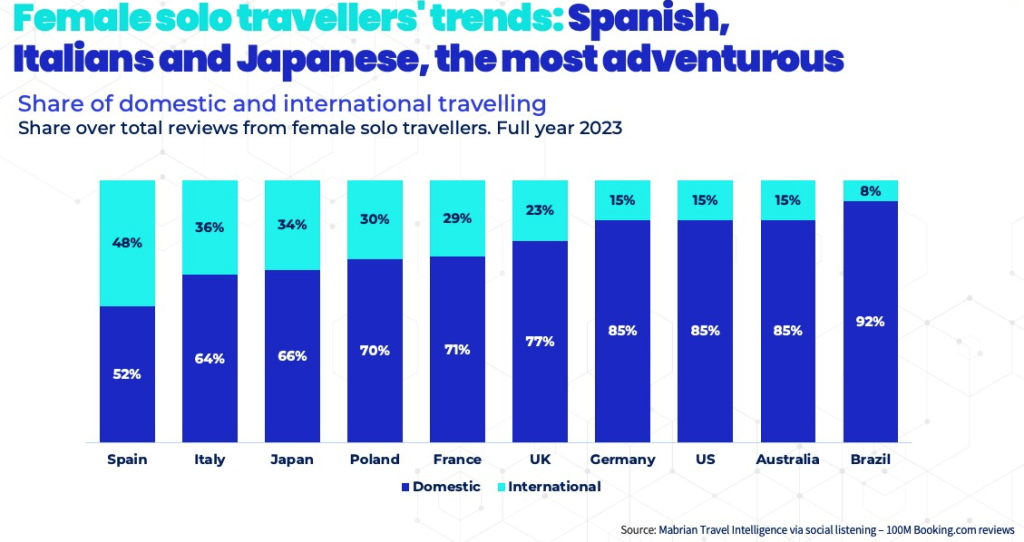
Source: Mabrian, 2024
It is not surprising that domestic and European destinations are the most popular amongst solo female travellers. Europe is generally perceived as a safe destination for women to travel. There are also many well-known destinations further afield and off the beaten track. Destination cities like London, Paris, Tokyo, Madrid, Rome and Berlin tend to be the most popular.
Many female solo travellers also visit developing destinations, as proven by the wide number of tour operators that sell to this market and the destinations they travel to. Online travel publications and blogs provide female travellers with ideas about destinations beyond Europe. These publications include:
- Time Out’s best destinations for solo female travel include Japan, Guatemala, Vietnam and Sri Lanka.
- Lonely Planet’s best destinations to visit in Asia include Luang Prabang in Laos, Kerala in India, Chiang Mai in Thailand and Uzbekistan.
- The blog World of Wanderlust includes Iceland, Chile and Bali in its list of best destinations for solo female travellers.
- German publication Reise und Preise has ten dream destinations for women travelling alone. These include Thailand, Laos, Morocco and Cuba.
- Italian online magazine Donne published a list of the seven most beautiful and safe places to travel alone if you are a woman.
4. What does the tour operator market for women-only travel look like?
The European market for women-only travel is substantial. The USA is the largest and best established market, but it is important to remember that online tour operators have a global reach. Female travellers do a lot of research to find their perfect trip. They may book with American operators if the package is right for them.
There are two types of tour operators that provide women-only travel products. One type is tour operators that specialise in women-only travel; the second is tour operators with women-only segments. You can find a selection of operators on the market in the table below.
Table 4: Tour operators in the women-only travel market
| Tour Operator Market for Women-only Travel |
Specialist Tour Operators Europe Gutsy Girls (UK) Mujer & Viajera (Spain) Tacones Viajeros (Spain) Travel Queen (UK) Viagginrosa (Italy) Walking Women (UK) USA |
Tour operators with women-only segments Europe Cart Orange (Italy) Intrepid Travel (UK) L’Odyssee du Papillon (France) On the Go Tours (UK) Sidetracked Adventure Travel (UK) SKR (Germany) TUI (Germany, France, UK) Voyages Leonard (France) Voyages Pirates (France) USA |
Source: Acorn Tourism Consulting, 2024
Tour operators who work in the women-only sector are very passionate about their clientele. They work hard to reassure their women travellers. They understand that they have different needs from other traveller groups, like mixed gender couples and families. Making sure women feel safe and can bond with other female travellers is very important to them. To supply this market, you must match their aspirations. Read the text below about a women-only tour operator to get an idea of how they work.
Tour Operator Insight

Megan Ryder-Burbidge, Sororal
We are a young business, just two years old, that has steadily grown from the ground up. As a socially conscious tour operator and travel brand, we are bold in our advocacy for creating a supportive and equality-focused industry. Our mission is to partner with women-owned, women-run and women-led businesses, contributing to their long-term economic security.
While we primarily work with suppliers wholly owned or managed by women, we understand it can be challenging to find 100% women-run businesses in male-dominated sectors like transportation. In such cases, we ensure that women play a key role in the supplier’s operations, whether by leading women’s initiatives or championing gender equality.
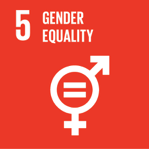
At the heart of our business model is the Fifth Sustainable Development Goal (SDG): achieving gender equality and empowering women and girls. This focus enables us to align every trip and service we offer with this objective.
We currently offer women-only tours to destinations like Kenya and Morocco. Our aim is to create recurring tours to maximise long-term benefits for both the communities we visit and the women who lead and participate in our trips. Sororal’s services are perfectly aligned with its goal of addressing gender inequality. The company works closely with women-owned and women-led businesses to ensure its travel experiences contribute to the economic empowerment of women. Sororal emphasises the creation of safe, empowering travel environments and fostering meaningful, respectful cultural exchanges. By focusing on sustainable, community-driven collaborations, Sororal ensures that its services benefit travellers and the women and communities it engages with. This alignment with gender equality and empowerment goals is central to Sororal’s mission, driving its travel offerings and broader impact efforts.
It is essential for suppliers that work with women-only tour operators to demonstrate their commitment to women’s empowerment and long-term benefit. To appeal to this market, your buyers will want to know:
- Why do you focus on women-only tours? What’s your story? Women appreciate understanding the message behind the services you offer.
- How specifically do you support female clients? What makes your business stand out as a women-friendly supplier?
- How do you support local women, communities and your team through your business?
Female travellers do lots of research before travelling to make sure they are fully informed about the destinations, including issues they might face when they arrive. Female travel bloggers are a big source of inspiration. Most blogs provide information about packing tips, top destinations, travel costs and learning a new language. Most female bloggers specialise in solo travel:
- Absolute Lucy
- Adventurous Kate
- Girl about the Globe
- Lost with Purpose
- The Blonde Abroad
- World of Wanderlust
- Young Adventuress
There are also several online communities for women and other women-owned or managed businesses that support the women-only market. These include:
- Solo Female Traveler Network – This network for women travellers and offers meetup tours in various destinations. It has a Facebook page for members.
- Greether – An organisation that connects women travellers with verified local women at its destinations.
- Adventurely – A meet up app that helps solo travellers, digital nomads and local adventure seekers to find, share and book experiences together.
- Girls that Scuba –The world’s largest scuba diving community for women. This is an interesting female community as the diving tourism industry is dominated by men.
- NomadHer – An app that helps women travellers to connect that currently has more than 200,000 members from more than 180 different countries.
- WOMEN LOVE TRAVEL – A Group for Traveling Women over 40 – A private Facebook community.
The women-only tour market from Europe is a good one to target, particularly if your business is women-owned or managed. Your business is in a unique position to understand women, what their needs are and how you can meet them. However, it will be important to get your messaging right so that you can allay their worries and offer travel experiences they want.
To do business with European tour operators, use the CBI studies to help. The most useful studies are: What are the requirements for tourism services in the European market, Tips for doing business with European tourism buyers and Tips for organising your tourism services export to Europe.
5. How to target your business at women
Aiming your tours at the women-only market and making it female-friendly requires a thoughtful approach. You will need to focus on safety, inclusivity and authenticity, and provide activities relevant to the female travel market. You will need to align your business around the empowerment and development of women. This means your staff, guides and other services you provide, like transport and accommodation. You will need to focus on women in the communities and groups with which your business interacts.
Here are some tips to help you target the women-only market.
Offer women-only tours: Design interesting and fulfilling trips exclusively for women. Emphasise connecting with women travellers to share experiences to make them more comfortable. Highlight places that are safe to travel in. Make sure you offer suitable activities, such as wellness, yoga and cultural workshops that cater to women’s interests and needs. Ensure there are immersive interactions with local women and communities for authentic experiences. Include local cultural insights so women are aware of the norms and behaviours that may affect their experiences.
Take a look at Ntanda Ventures, which offers women-only safaris in its portfolio of safari trips in Zambia.
Figure 4: Offer activities that women like to do, like yoga sessions on the beach
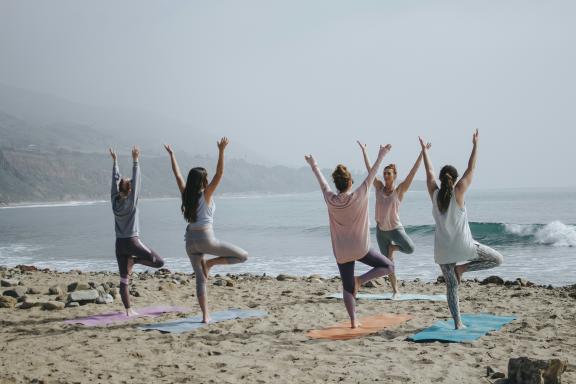
Source: Kaylee Garrett at Unsplash, 2018
- Support other women-owned local businesses: If you work with other suppliers, make sure you choose businesses that are women-owned or managed, or that they publicly support women’s rights and female empowerment. Offer experiences in which travellers can meet and learn from local female entrepreneurs, artists and craftswomen. This will create enriching experiences and community support.
Provide safe accommodation options: Partner with hotels, hostels and homestays that prioritise women’s safety, offering secure, well-lit accommodation. Women-only establishments are best. You must be able to ensure safe spaces for women travelling alone. Try to negotiate good deals for solo female travellers who want single rooms, as single room occupancy supplements can be very expensive. They will appreciate the support.
Take a look at these examples of women-only properties. Bliss Sanctuary for Women in Bali is a wellness hotel in a peaceful setting. The Nine Hours Woman Kanda in Japan is a capsule hotel that offers a basic safe space for women. In Guatemala, Colonial Charm in Antigua offers simple accommodation for women.
Local Female Guides: Hire or partner with local female guides who can offer a unique perspective and build trust with female travellers. Guides are the most important part of the trip. Great guides make for great trips. An average or poor guide could ruin the experience. Your guides should be able to give lots of background information on the destination along with etiquette ‘dos and don’ts’. A good icebreaker could help travellers learn some of the language too.
Invest in guides who are outgoing and personable, and train them well. Pay attention to language too, as they should be able to speak the language of the travellers to a high standard. India Women Tours provides female-led tours for women-only groups, families and couples.
- Use your website to provide advice: Write informative guides or blogs for women travellers about staying safe in your destination. Include other things too, like cultural tips and packing advice. Use inclusive language and images that represent women of different ages, ethnicities and backgrounds. Show that your business welcomes all women, whether they are traveling solo, with partners or in groups.
- Use social media to build trust: Use social media platforms like Instagram and Facebook to promote your business and values. Post relevant content regularly and consider working with female bloggers to enrich your messages. You can use the CBI study How to be a successful tourism business online to develop or improve your website and social media activities.
- Provide verified transportation: Ensure the transport you offer is well-maintained for safety reasons. Use female drivers if possible. You can also use this to promote your commitment to empowerment.
Best practice case studies
These tour operators are good examples of businesses that focus on the women-only travel market. You can learn from them. Adventures with Locals sells directly to travellers (B2C, Business to Consumer) while Matoke Tours is a B2B (Business to Business) operator, selling trips to other travel suppliers.
| Best practice case study #1: Adventures with Locals (B2C) |
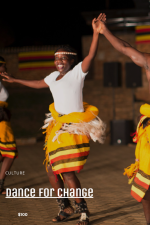
Adventures with Locals is a wholly female owned tour operator in Rwanda that supports and empowers young, local, female guides. It provides training in guiding and tourism, which helps local communities. Their customers are mixed gender, but the way they operate their business is focused on the empowerment and skill development for local women. The experiences they offer are all focused on being ‘local’. Guides are local, the accommodation provided is local, and they operate responsible tourism practices. The operator contributes to tree planting schemes for every trip it operates. They offer eco safaris, cultural journeys and a mix of the two to provide a range of immersive and authentic experiences, led by local and well-trained guides. Connecting with local people and communities is at the heart of their trips. They also offer free walking tours of Kampala. This is a great way for young guides to learn their trade and to upsell to other tours. |
| Best practice case study #2: Matoke Tours (B2B) |

Matoke Tours has been active in Uganda since 2007. In 2019, they diversified their business to focus on women-only travel, providing cultural and immersive trips and concentrating on providing real connections between travellers and local people. The operator piloted a female tour guide training programme in cooperation with a local tourism and hospitality training provider. 34 participants completed the programme, making it a success and, in 2023, they organised their first leadership bootcamp for women in tourism. The bootcamps are now annual. They have developed a tour aimed specifically at women: the Sisterhood Safari in Rwanda and Uganda. The trip is fully guided by female tour leaders, with solo excursions supervised by other Ugandan women. As well as wildlife safaris, the 13-day group tour involves visits to local communities for dance workshops, cooking classes and a women’s coffee cooperative. |
6. Sustainability is expected
The women-only tour market is a sustainable niche market. The desire for authenticity, immersive experiences and strong connections with local communities and landscapes means it deeply involves sustainability and responsible tourism. It is important that you manage the rest of your business with sustainable principles too.
If you sell your trips to European tour operators, they will want to know that your business is sustainable at the front end or point of sale as well as at the back end, in your offices and in your supply chain. While they may not insist on you being a sustainably certified business, they will want details of your sustainability actions and you must be able to prove them.
You should explore becoming sustainably certified. Increasing numbers of European tour operators are sustainably certified these days, and being a sustainable tour operator is now the norm. Generally, European tour operators will only work with local operators that align with their principles of sustainability. Being certified will give you an edge over competitors. You can find out more about sustainability certification in the CBI study How to be a sustainable tourism business.
Here are some ideas for how you can make your business more sustainable.
- Make sure your suppliers, like accommodation providers and transport suppliers, align their business values with yours. Visit them regularly to make sure they do what they say they do.
- Think about incorporating low-impact transport options into your tours if possible. These can be cycle tours, walking tours or electric vehicles.
- Commit to offsetting carbon with a local organisation. You could get involved in initiatives like the Uganda Gender Responsive Safe Water Project, which proactively supports gender equality. Investigate schemes in your destinations. The website Circular Ecology is a good place to find organisations to support.
- Promote local, women-owned businesses to your guests. These could be restaurants and bars, artisan craft shops, local artists and indigenous communities. You could negotiate a small discount on purchases to encourage visitors.
- Make sure that any food supplied during the tour is locally sourced and in-season. Focus on plant-based and organic products if possible.
- Do not allow or limit the use of single-use plastics on your tours, like water bottles, plastic straws and plastic bags. Provide guests with refillable water bottles – you must ensure there is a potable drinking water supply that is readily available.
- Advise your guests how to behave in a responsible manner when it comes to using resources and dealing with waste. Typical messages could include ‘Turn Off Lights/Taps When Not in Use’, ‘Leave No Trace’, ‘Only Take Photos’ and ‘Don’t Interact with the Wildlife’. Provide the right waste bins for separation and recycling or make sure they take their waste and dispose of it responsibly.
Read the CBI reports on sustainability to help make your business as sustainable as possible. These reports are: How to be a sustainable tourism business, Tips to go green in the tourism sector and Tips on how to become more socially responsible in the tourism sector.
7. Emerging trends and developments
Reinforcing the findings in this study, women-only travel and solo female travel are significant growth markets in the tourism sector today. With two-thirds of global travellers estimated to be female, it is a market with significant opportunities. Pay particular attention to women travellers aged 45+ as this market is growing faster than others.
Women-only solo trips are a key global trend
As we have seen, women-only trips have become a key trend in the tourism sector. This is proven by the growing numbers of female travellers, supported by growing numbers of specialist tour operators on the marketplace. This market aligns well with the other significant tourism trend of authentic and immersive experiences, staying local and close to nature, and making real connections with local communities.
As a result, if you can align your business to offer this market authentic and immersive experiences and meet specific needs to make real connections with communities and destinations, you will be well-placed to capture this lucrative and growing market.
Women aged 45+ and baby boomers are the fastest growing groups
The largest growth in the women-only travel segment comes from those aged 45+. In the 65+ segment, the growth rate has risen most: from 4% in 2019 to 18% in 2022. In this group, 96% of women who have never travelled on their own before would be more likely to do so as part of a group tour. Across Europe, there has been a notable societal shift that gives older women the freedom to travel alone, while this was not as common just a decade ago.
Figure 5: Female Baby Boomers are a growth market in the women-only travel segment
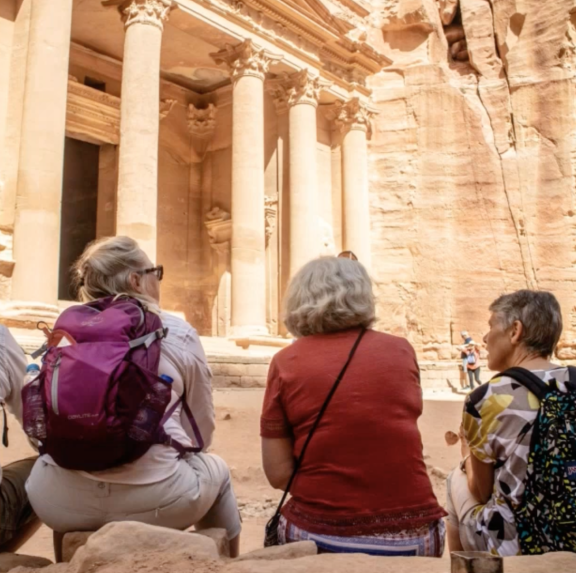
Source: Explore, 2024
In another break from tradition, more women are travelling without their husbands or partners. In 2023, tour operator Road Scholar found that 60% of their solo travellers were married women travelling alone. Reasons given included partners’ lack of or different travel interests.
Similarly, tour operator El Camino Travel specialises in group tours for solo travellers. It has reported more female clients aged 55+ who have started to travel without their partners. This operator began life as a traditional tour operator but has evolved into a woman-only travel operator, indicative of the growing power of solo female travel.
However, it is important not to focus solely on the older generation: Gen Y and Gen Z are independent and enthusiastic travellers, preferring to spend money on travel rather than things. Research suggests they are choosing to travel solo at a younger age than their predecessors. A survey found that 58% of Gen Z women were very interested in travelling alone to international destinations for reasons related to empowerment and personal growth. They also stated a wish to enjoy new experiences beyond what they would normally choose to do.
Acorn Tourism Consulting Limited carried out this study on behalf of CBI.
Please review our market information disclaimer.
Search
Enter search terms to find market research

